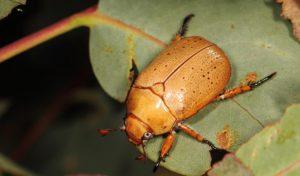The Christmas beetles are a genus of beetles belonging to the family of scarab beetles including 35 species. They are commonly seen during the Australian summer around the Christmas season, resulting in their name.
Size: 2-3 cm
Color: The elytra are light or dark brown or even green. A green-yellow iridescence is observed in certain beetles.
Other Characteristic Features: While flying, they generate a lot of noise. They are also erratic fliers, often colliding into objects when in flight.
They are pale cream, with a brown head. Like other beetle larvae, it is also ‘C’ shaped measuring around 2.5 cm. The beetle spends this stage deep underground.
After maturing, the larvae come closer to the soil’s surface to begin pupation.
They are laid in soil or compost in the spring and early summer, with females laying 20-40 eggs at a time.
| Lifespan | 24 months |
| Distribution | Australia |
| Habitat | Woodlands |
| Predators | Birds of prey like currawongs, possums, and predatory wasps |
| Seasons active | Summer |
| Host Plants | Eucalyptus |
| Diet of adults | Leaves of eucalyptus plants |

Both the larva and adults are responsible for dieback in eucalyptus plants, leading to the plants dying from the tip of the roots or leaves.

Image Source: lh5.ggpht.com, i1.treknature.com, amazonaws.com, abc.net.au, entomologa.ru, candide.com, parody.fandom.com
The Christmas beetles are a genus of beetles belonging to the family of scarab beetles including 35 species. They are commonly seen during the Australian summer around the Christmas season, resulting in their name.
Size: 2-3 cm
Color: The elytra are light or dark brown or even green. A green-yellow iridescence is observed in certain beetles.
Other Characteristic Features: While flying, they generate a lot of noise. They are also erratic fliers, often colliding into objects when in flight.
They are pale cream, with a brown head. Like other beetle larvae, it is also ‘C’ shaped measuring around 2.5 cm. The beetle spends this stage deep underground.
After maturing, the larvae come closer to the soil’s surface to begin pupation.
They are laid in soil or compost in the spring and early summer, with females laying 20-40 eggs at a time.
| Lifespan | 24 months |
| Distribution | Australia |
| Habitat | Woodlands |
| Predators | Birds of prey like currawongs, possums, and predatory wasps |
| Seasons active | Summer |
| Host Plants | Eucalyptus |
| Diet of adults | Leaves of eucalyptus plants |

Both the larva and adults are responsible for dieback in eucalyptus plants, leading to the plants dying from the tip of the roots or leaves.

Image Source: lh5.ggpht.com, i1.treknature.com, amazonaws.com, abc.net.au, entomologa.ru, candide.com, parody.fandom.com